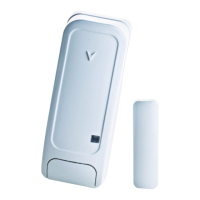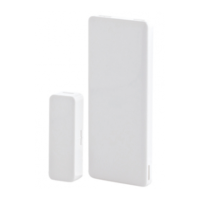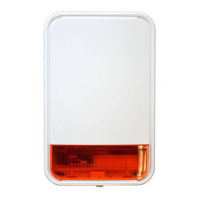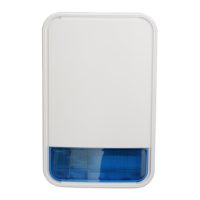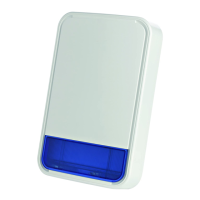6. COMPLIANCE WITH STANDARDS
The MC-312 PG2 complies with the following standards:
Europe EN 301489, EN 50130-4, EN 300 220, EN 62368-1, EN 60950-22, EN 50130-5, EN 50131-5-3, EN 50131-6 Type C, EN 50131-2-6 Grade
2 Class IV
Hereby, Visonic Ltd. declares that the radio equipment type MC-312 PG2 is in compliance with Directive 2014/53/EU.
The full text of the EU declaration of conformity is available at the following internet address:
http://www.visonic.com/download-center.
EN 50131-1 Security Grade: According to EN 50131-1 this equipment can be applied in installed systems up to and including
Security Grade 2.
EN 50131-1 Environmental Class: Class IV
Certified by Applica Test & Certification AS in accordance with EN 50130-4, EN 50130-5, EN 50131-5-3, EN 50131-6, EN
50131-2-6, EN 50131-1
The Power G peripheral devices have two- way communication functionality, providing additional benefits as described in the technical brochure.
This functionality has not been tested to comply with the respective technical requirements and should therefore be considered outside the
scope of the product’s certification.
UK: The MC-312 PG2 is suitable for use in systems installed to conform to PD6662 at Grade 2 and environmental CLASS IV
and BS8243
USA: FCC -CFR 47 part 15, UL- UL634, UL 1023/UL 1610
Canada: IC-RSS-247, ULC- ORD-C634, ULC S304
Note: Only devices operating at 912-919 MHz are tested and listed by UL/ULC
Note: This equipment has been tested and found to comply with the limits for a Class B digital device, pursuant to part 15 of the FCC Rules. These limits
are designed to provide reasonable protection against harmful interference in a residential installation. This equipment generates, uses and can radiate
radio frequency energy and, if not installed and used in accordance with the instructions, may cause harmful interference to radio communications.
However, there is no guarantee that interference will not occur in a particular installation. If this equipment does cause harmful interference to radio or
television reception, which can be determined by turning the equipment off and on, the user is encouraged to try to correct the interference by one or
more of the following measures:
-Reorient or relocate the receiving antenna.
-Increase the separation between the equipment and receiver.
-Connect the equipment into an outlet on a circuit different from that to which the receiver is connected.
-Consult the dealer or an experienced radio / TV technician for help.
l This Class B digital apparatus complies with Canadian ICES-003.
l Cet appareil numerique de la classe B est conforme a la norme NMB-003 du Canada.
WARNING! Changes or modifications to this unit not expressly approved by the party responsible for compliance could void the user’s authority to
operate the equipment.
This device complies with Part 15 of the FCC Rules and with ISED license-exempt RSS standard(s). Operation is subject to the following two conditions:
(1) This device may not cause harmful interference, and (2) this device must accept any interference received, including interference that may cause
undesired operation.
Le présent appareil est conforme aux CNR d'ISED applicables aux appareils radio exempts de licence. L'exploitation est autorisée aux deux conditions
suivantes : (1) l'appareil ne doit pas produire de brouillage, et (2) l'utilisateur de l'appareil doit accepter tout brouillage radioélectrique subi, même si le
brouillage est susceptible d'en compromettre le fonctionnement.
To comply with FCC and IC RF exposure compliance requirements, the device should be located at a distance of at least 20 cm from all persons during
normal operation. The antennas used for this product must not be co-located or operated in conjunction with any other antenna or transmitter.
Le dispositif doit être placé à une distance d'au moins 20 cm à partir de toutes les personnes au cours de son fonctionnement normal. Les antennes
utilisées pour ce produit ne doivent pas être situés ou exploités conjointement avec une autre antenne ou transmetteur.
7. SPECIAL COMMENTS
Even the most sophisticated detectors can sometimes be defeated or may fail to warn due to: DC power failure / improper connection, malicious
masking of the lens, tampering with the optical system, decreased sensitivity in ambient temperatures close to that of the human body and unexpected
failure of a component part.
The above list includes the most common reasons for failure to detect intrusion, but is by no means comprehensive. It is therefore recommended that
the detector and the entire alarm system be checked weekly, to ensure proper performance.
An alarm system should not be regarded as a substitute for insurance. Home and property owners or renters should be prudent enough to continue
insuring their lives and property, even though they are protected by an alarm system.
D-307174 MC-312 PG2 Installation Instructions 6
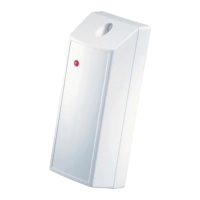
